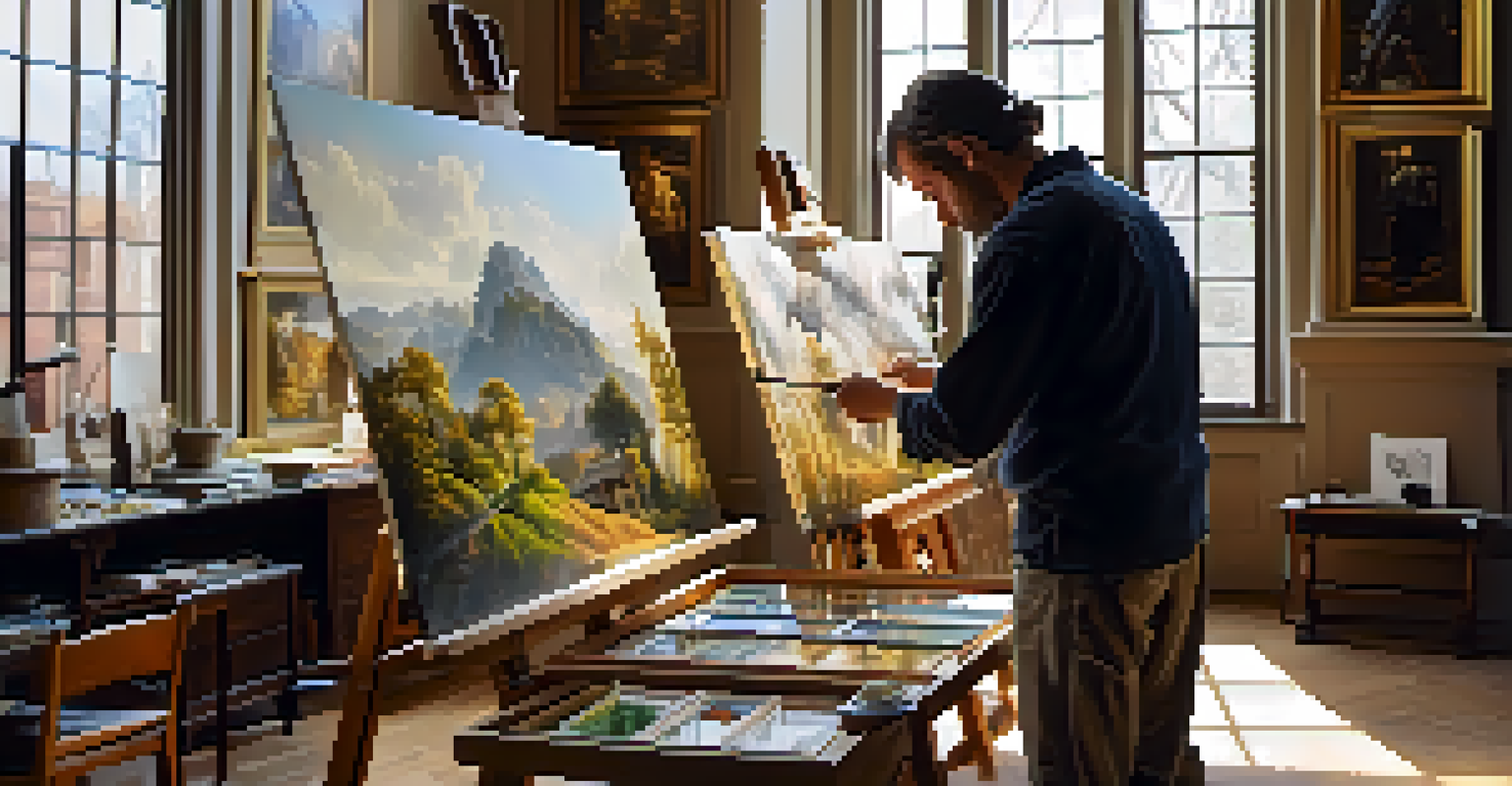Digital Art vs. Traditional Art: Preservation Strategies

Understanding Digital Art and Its Unique Challenges
Digital art, created using software and digital tools, offers artists limitless possibilities. However, its ephemeral nature raises concerns about preservation. Unlike physical artworks, digital files can easily become obsolete as technology evolves, making it crucial for artists to adopt effective strategies for longevity.
Art is not freedom from discipline, but disciplined freedom.
For instance, a digital painting saved in an outdated format may become inaccessible as software updates roll out. Artists must stay informed about file types and storage options to ensure their work can be viewed in the future. It's similar to how vinyl records and cassette tapes have experienced revivals, showing that preservation is essential for any medium.
Ultimately, understanding these challenges empowers artists to take proactive steps in preserving their digital creations. By recognizing the risks, they can implement solutions that safeguard their work for generations to come.
Traditional Art: Techniques and Materials for Longevity
Traditional art encompasses various mediums, including painting, sculpture, and printmaking, each with its own preservation techniques. Artists often use archival-quality materials to enhance the longevity of their work. For example, acid-free paper and paints can significantly slow down deterioration, ensuring that masterpieces remain vibrant over time.

Moreover, proper storage conditions, such as controlled humidity and temperature, play a vital role in preserving traditional artworks. Just like how a well-kept garden thrives, an artwork requires the right environment to flourish. Regular maintenance, such as cleaning and restoration, also contributes to the preservation of these cherished pieces.
Preservation Challenges in Digital Art
Digital art's fleeting nature requires artists to adopt strategies for preserving their work amid evolving technology.
Thus, incorporating these techniques not only protects traditional art but also reinforces its value in the art world. Artists and collectors alike must prioritize preservation to maintain the integrity of their creations.
The Role of Technology in Preserving Digital Art
Technology plays a pivotal role in the preservation of digital art, offering innovative solutions to ensure its longevity. Cloud storage, for instance, allows artists to back up their files securely and access them from anywhere. This flexibility is crucial as it mitigates the risk of loss due to hardware failures or accidental deletions.
The only way to preserve art is to keep it alive in the hearts of people.
Digital archiving tools also enable artists to catalog their work effectively, making it easier to manage and retrieve files. Imagine having a well-organized digital closet where every piece of art is just a click away! Furthermore, utilizing platforms that specialize in digital art preservation can provide additional layers of security.
As technology continues to advance, artists must adapt and integrate these tools into their preservation strategies. Embracing these innovations not only protects their work but also enhances its accessibility for audiences worldwide.
Physical Preservation: Best Practices for Traditional Art
For traditional art, best practices in physical preservation are essential to maintain its beauty and integrity. This includes using proper framing techniques that protect artworks from harmful UV rays and dust. For example, museum-quality glass can shield paintings while allowing viewers to appreciate their details without risking damage.
Moreover, regular inspections and professional conservation services can help identify potential threats to artworks. Just as we schedule regular check-ups for our health, artworks deserve the same attention to ensure they remain in optimal condition. Additionally, documenting the artwork's condition over time can aid in future restoration efforts.
Best Practices for Traditional Art
Using archival-quality materials and proper storage techniques is essential for extending the life of traditional artworks.
By implementing these best practices, artists and collectors can significantly extend the life of traditional artworks. This commitment to preservation reflects a deep respect for the craft and its historical significance.
Cultural Significance: Why Preservation Matters
Preservation of both digital and traditional art holds immense cultural significance. Every artwork tells a story, reflecting the values, beliefs, and history of its time. By safeguarding these creations, we honor the artists and the messages they sought to convey, ensuring that future generations can connect with their heritage.
Moreover, preserving art contributes to a broader understanding of cultural evolution and artistic expression. It's akin to piecing together a puzzle; each artwork adds to the narrative of human creativity. This collective memory fosters appreciation for diversity and innovation in the arts.
In essence, the act of preserving art transcends mere maintenance; it becomes a vital part of our cultural legacy. Artists, collectors, and institutions share the responsibility of preserving these treasures for the enrichment of society.
Collaborative Efforts: Artists and Institutions Unite
Collaboration between artists and institutions is crucial for effective art preservation. Museums and galleries often provide resources and expertise that can help artists maintain their work. By working together, they can create comprehensive preservation strategies that address both digital and traditional art.
For example, workshops and seminars on best practices in art preservation can educate artists about the latest techniques and tools. This knowledge-sharing fosters a supportive community where everyone benefits from collective expertise. Picture a vibrant ecosystem where artists thrive, supported by the institutions that value their contributions.
Collaboration Enhances Art Preservation
Partnerships between artists and institutions are vital for developing effective preservation strategies for both digital and traditional art.
Ultimately, these collaborative efforts empower artists to take ownership of their preservation journey. By uniting in this mission, they can ensure that their art continues to inspire and resonate with audiences for years to come.
Future Trends: The Evolution of Art Preservation
As we look to the future, the evolution of art preservation is poised to adapt to the changing landscape of both digital and traditional mediums. Emerging technologies, such as artificial intelligence and blockchain, promise to revolutionize how we document and safeguard artworks. These advancements could provide new ways to verify authenticity and track the provenance of art.
Additionally, the rise of virtual exhibitions and augmented reality experiences may reshape how we engage with art. Imagine exploring a virtual gallery where digital and traditional works coexist, each preserved in their own unique way. This innovative approach could enhance accessibility and appreciation for diverse art forms.

By embracing these future trends, artists and institutions can create dynamic preservation strategies that resonate with contemporary audiences. The journey of art preservation is ongoing, and staying attuned to these changes will be vital in safeguarding our creative heritage.